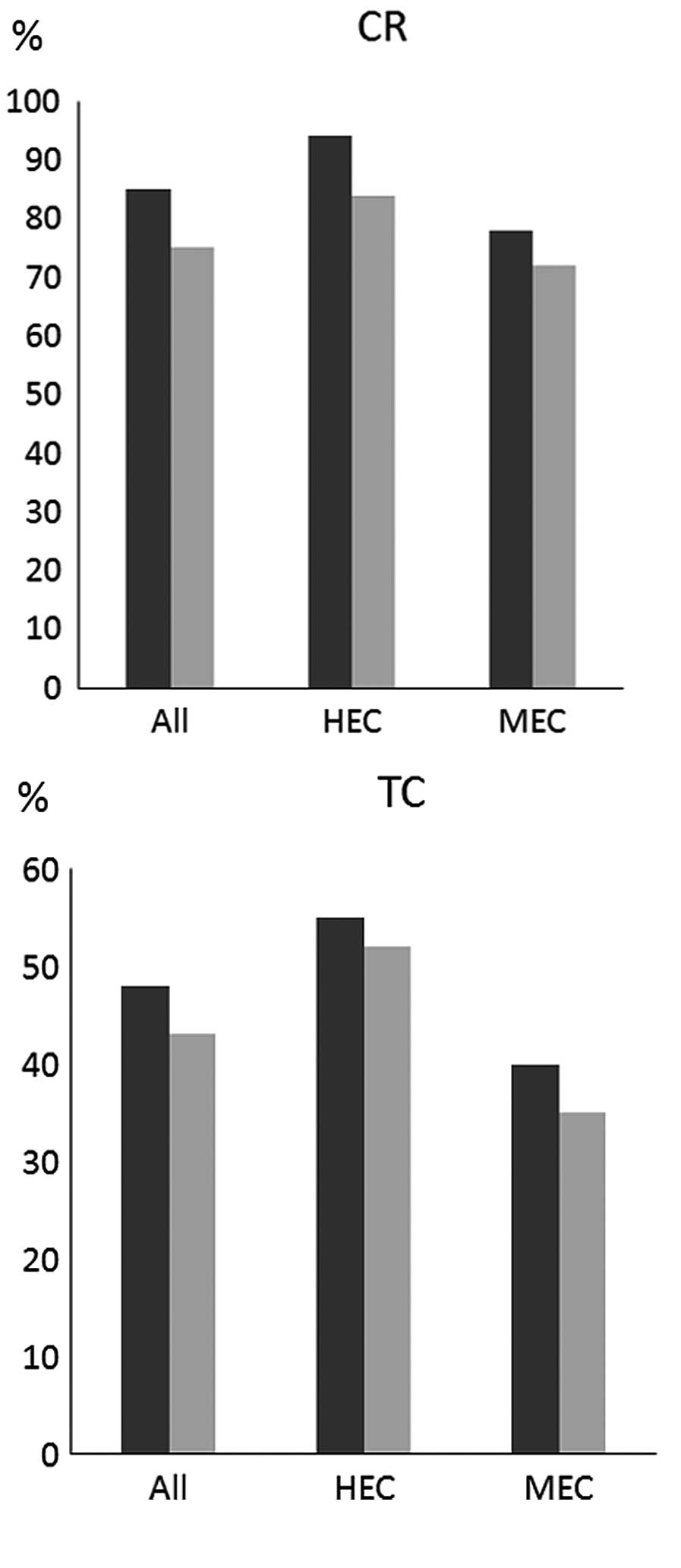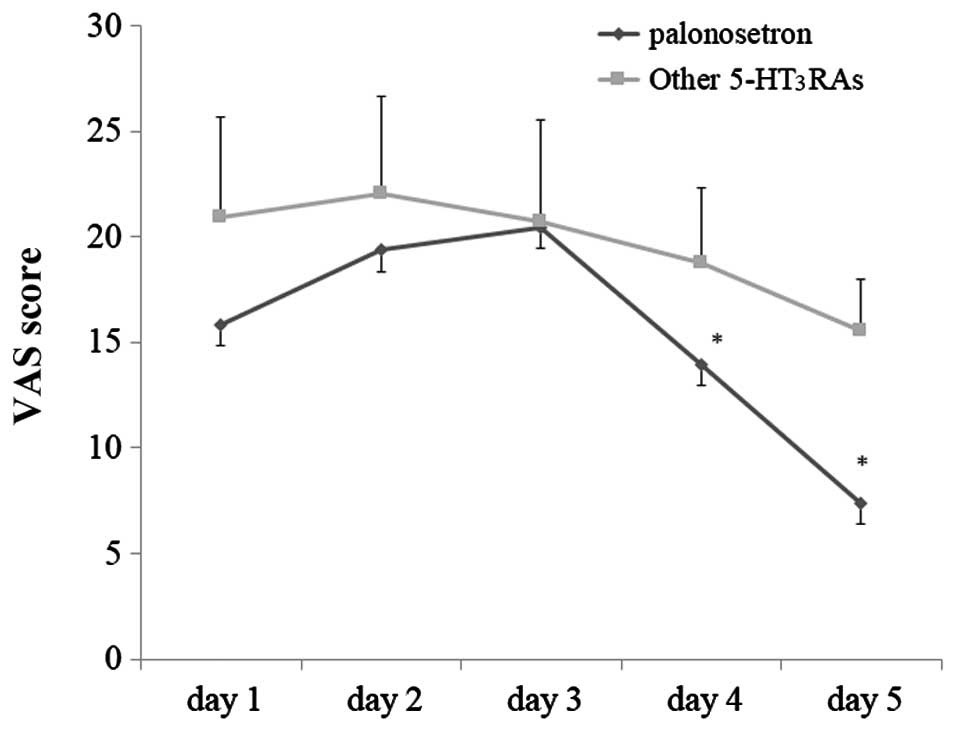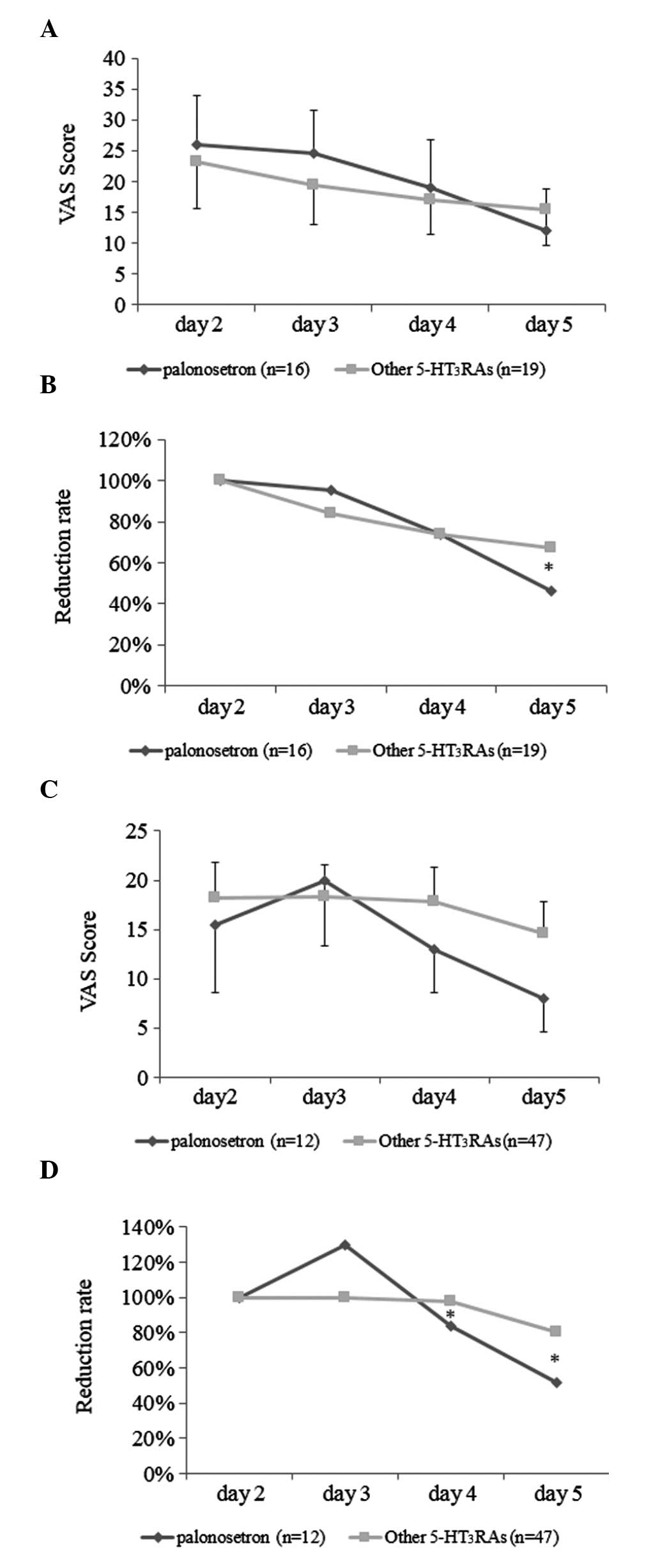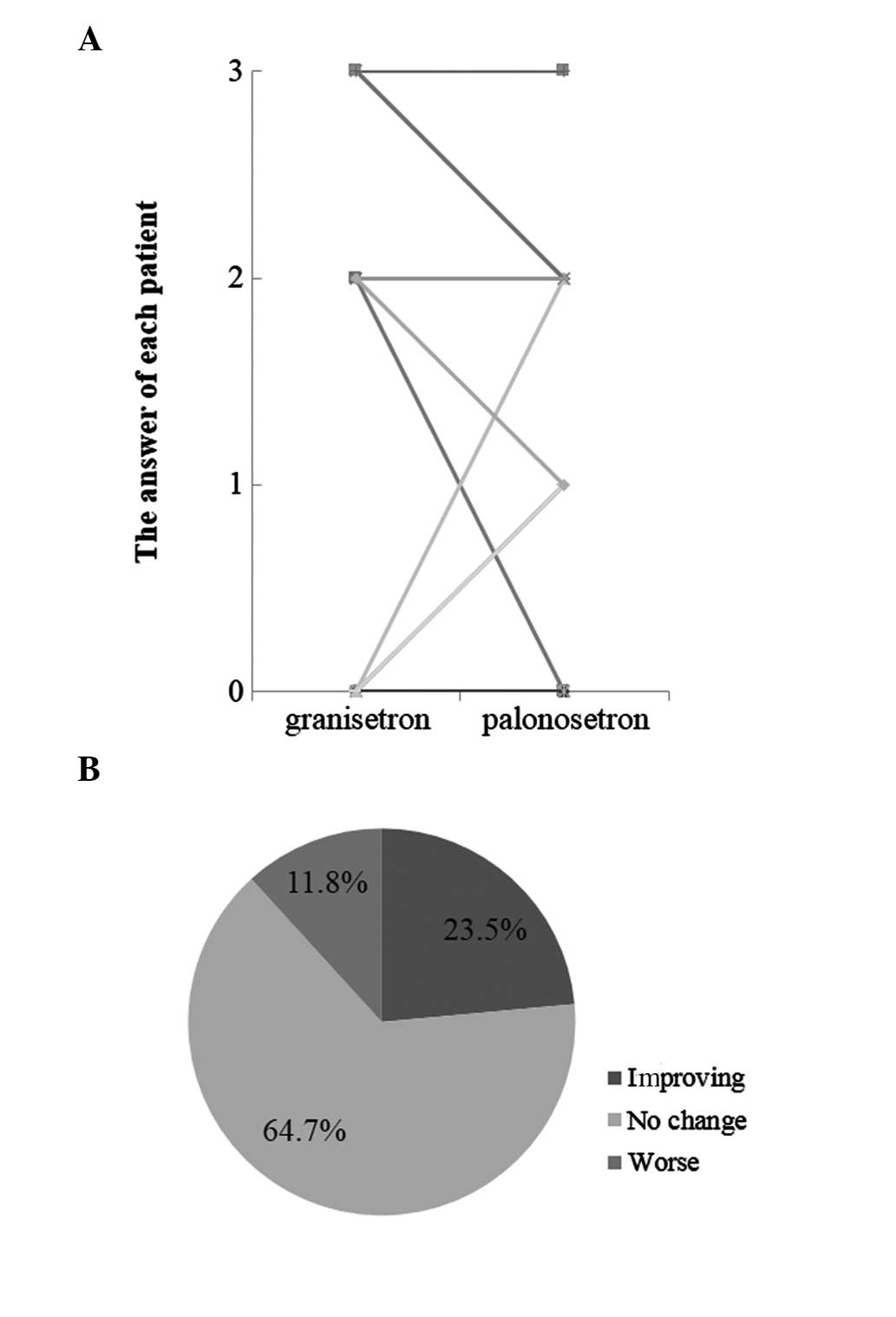Palonosetron exhibits higher total control rate compared to first‑generation serotonin antagonists and improves appetite in delayed‑phase chemotherapy‑induced nausea and vomiting
- Authors:
- Published online on: February 20, 2014 https://doi.org/10.3892/mco.2014.263
- Pages: 375-379
Abstract
Introduction
Chemotherapy-induced nausea and vomiting (CINV) is an adverse event that significantly impairs the patients’ quality of life (1). Thus, to ensure the continuity of chemotherapy, it is crucial to provide appropriate supportive care to prevent CINV.
With regard to preventing CINV, antiemetic agents corresponding to each emetogenic risk have been recommended in antiemetic guidelines. Novel antiemetics, such as aprepitant, a selective neurokinin-1 receptor antagonist (NK1RA) and palonosetron, a long-acting second-generation serotonin (5-HT3) receptor antagonist (5-HT3RA), were relatively recently developed. Consequently, the guidelines of the American Society of Clinical Oncology (2), the National Comprehensive Cancer Network (3) and the Multinational Association for Supportive Care in Cancer (4) were updated to incorporate aprepitant and palonosetron and their use as antiemetics was recommended, corresponding to either high or moderate emetic risk.
Additionally, in Japan, the antiemetic guidelines issued by the Japan Society of Clinical Oncology (JSCO guidelines) (5) recommend two-drug combinations of a 5-HT3RA and dexamethasone for use in moderately emetogenic chemotherapy (MEC) and three-drug combinations of a 5-HT3RA, dexamethasone and NK1RA for use in highly emetogenic chemotherapy (HEC).
The symptoms of nausea and vomiting are categorized as either acute-phase, defined as episodes occurring within 24 h of the administration of chemotherapy, or delayed-phase, defined as episodes occurring after 24 h (6,7). The development of granisetron, a first-generation 5-HT3RA, was shown to mitigate acute nausea and vomiting (8), although its efficacy for delayed nausea and vomiting is limited (9). However, the more recently developed aprepitant (10) and palonosetron (11) have demonstrated promising outcomes in the control of acute- and delayed-phase nausea and vomiting.
In the JSCO guidelines, there is a paragraph highlighting the need to consider the evidence-based proper use of anti-emetics upon correctly evaluating the emetogenic risks of each agent. However, the frequency of CINV is greatly dependent on the type and combination of chemotherapeutic agents, which requires further investigation.
Thus, in an attempt to assess the efficacy of the currently available antiemetic agents for nausea and vomiting following standard chemotherapy, we conducted a prospective study through the use of patient diaries on nausea and vomiting.
Materials and methods
Population
In the present study, participants were recruited among patients receiving HEC or MEC in the Ambulatory Therapy Center of our institution between August, 2010 and March, 2011. Patients with episodes of vomiting within 24 h prior to the administration of chemotherapy, those who required the administration of HEC or MEC on or after day 2 and those who received radiation therapy were excluded from the study.
The study protocol was approved by the Institutional Review Board prior to the initiation of the study and all the patients provided written informed consent prior to enrollment.
Assessment of antiemetic efficacy and safety
The episodes of nausea and vomiting were assessed through the use of patient diaries from the day of the treatment until day 5 (Fig. 1). The efficacy endpoints were defined as follows: Complete response (CR), no emetic episodes and no rescue therapy; and total control (TC), no emetic episodes, no rescue therapy, no nausea and no appetite loss. The patients’ diaries, in which the scores on the visual analogue scale (VAS) for assessing the severity of nausea (12,13), the presence of vomiting episodes and the appetite levels were recorded by the patients themselves over a period of 5 days, were collected and assessed. The appetite levels were recorded with a four-grade assessment system: Normal, appetite diminished due to nausea, food portions decreased due to nausea and almost no food intake due to nausea.
Statistical analysis
In order to compare the assessments of antinausea or antiemetic activity, a statistical analysis was performed using the χ2 test. The level of significance was set at 0.05 for all the tests. All the statistical analyses were performed using JMP software, version 9.0.2 (SAS Institute, Cary, NC, USA).
Results
Patient characteristics
The characteristics of the 103 patients are shown in Table I. The patients included 41 men and 62 women, with a median age of 61.6 years (range, 36–81 years). A total of 42 patients received HEC and 61 patients received MEC. The tumor types included colorectal (45), breast (24), gynecological (9), lung (8), biliary tract (6), gastric (6) and other types of cancer (5). The chemotherapeutic regimens used were as follows: for HEC, fluorouracil + epirubicin + cyclophosphamide; cisplatin (CDDP) + gemcitabine; or CDDP + irinotecan (CPT-11); and for MEC, capecitabine + oxaliplatin/folinic acid + fluorouracil + oxiplatin ± bevacizumab (Bev); folinic acid + fluorouracil + irinotecan (FOLFIRI)/irinotecan + S-1 (IRIS) ± Bev; or CBDCA + paclitaxel. The four agents used as a 5-HT3RA were granisetron hydrochloride (granisetron), azasetron hydrochloride (azasetron), ramosetron hydrochloride (ramosetron) and palonosetron hydrochloride (palonosetron). One of these 5-HT3RAs plus dexamethasone and aprepitant (a three-drug combination) was administered to 42 patients.
Efficacy
The CR and TC rates in the delayed phase were assessed for all the patients and for those receiving HEC and MEC, by comparing the patients administered palonosetron (group P) to those administered a different 5-HT3RA (group X) (Fig. 2). The CR rates for all, HEC and MEC patients in group P vs. those in group X were 86 vs. 76%, 93 vs. 84% and 77 vs. 72%, respectively. The TC rates for all, HEC and MEC patients in group P vs. those in group X were 48 vs. 43%, 55 vs. 52% and 40 vs. 35%, respectively. Although both groups exhibited an improvement in the VAS scores in the delayed phase over time (Fig. 3), the changes exhibited by group P patients were more prominent compared to those exhibited by group X patients.
The changes in the VAS scores in the delayed phase (days 2–5) in HEC and MEC patients were further assessed. In HEC patients, the VAS scores on day 5 were lower in group P patients compared to those in group X patients (Fig. 4A). When the reduction in the VAS scores on days 3–5 in HEC was assessed by defining the scores of day 2 as 100%, the decrease in VAS scores on day 5 in group P patients was significantly more prominent, with a more significant improvement compared to that in group X patients (Fig. 4B). Furthermore, as regards MEC patients, the VAS scores in group P were also lower compared to those in group X on days 4 and 5 (Fig. 4C); when the relative reduction in VAS scores in group P patients after day 2 was assessed, the decrease in VAS scores on days 4 and 5 in group P patients was significantly more prominent compared to that in group X patients (Fig. 4D).
Furthermore, changes in food intake were assessed in 18 patients in whom granisetron was switched to palonesetron (Fig. 5). In the delayed phase, a total of 22.2% (4/18) of the patients attained increased food intake and exhibited improved appetite.
Discussion
5-HT3RAs, NK1RAs and dexamethasone are effective anti-emetic agents used to prevent CINV. In Japan, NK1RAs are currently covered by public health insurance and palonosetron has become available as a second-generation 5-HT3RA. These antiemetics are also recommended in guidelines published in the USA and Europe (2–4).
The efficacy of palonosetron was demonstrated in the present study. Palonosetron exhibited a greater efficacy compared to other conventional 5-HT3RAs, particularly on days 4 and 5, as it has a long half-life (14); it was also found to be effective in HEC and MEC in the delayed phase. In certain cases in the present study, granisetron was replaced by palonosetron in an attempt to achieve higher efficacy of the newly developed antiemetics to determine the effects of chemotherapy on food intake. Improvements in appetite were previously reported (11), particularly in the delayed phase, in one-quarter of the patients in whom the antiemetic agent was switched to palonosetron. There were no serious side effects and, although there has not yet been a listing of palonosteron in the Japanese guidelines (5), it was suggested that the use of palonosetron as a 5-HT3RA be prioritised over that of other available 5-HT3RAs.
Additionally, improvement of the VAS scores on days 4 and 5 is crucial in terms of maintaining the nutritional status and reducing the time of appetite loss. However, there were certain limitations to our study. When CR and TC rates in the delayed phase were assessed by HEC and MEC regimens, the TC rates for both groups were low; in particular, the TC rates in MEC were 33%, which is lower compared to the 51.9% previously reported (15). This discrepancy may be attributed to the TC rate in the present study being more strictly defined [i.e., complete control (CC) was previously defined as ‘no nausea and no vomiting’]. The other plausible cause for these discrepancies may be the fact that there were some cases in which dexamethasone was not administered on days 2 or 3. In fact, in those cases receiving the guideline-directed regimens, the CC rates were almost equivalent to those previously reported (data not shown). The detailed mechanism through which dexamethasone mitigates nausea and vomiting has not been fully elucidated (16); however, it is an evidence-based agent reported to exhibit high dose-dependent efficacy (17). The present study demonstrated that the CR and TC rates were decreased in the corresponding dexamethasone-free regimens, indicating that guideline-directed antiemetic therapies should be recommended. However, the development of dexamethasone-free regimens is required for patients who are unable to tolerate the adverse effects of dexamethasone, including hyperglycemia and insomnia (18,19).
The JSCO guidelines recommend the use of two-drug combinations for antiemetic regimens against CINV in MEC (20); however, by definition, the frequency of CINV episodes in MEC is 30–90% (21) and the addition of aprepitant to certain antineoplastic agents has been recommended. CPT-11-based regimens, including FOLFIRI and IRIS, one of the major chemotherapeutic regimens for colorectal cancer, are another example. Our results demonstrated that the CR and TC rates in CPT-11-based regimens were lower and the VAS scores were significantly higher compared to the other MEC regimens (data not shown). Thus, we concluded that it may be necessary to include NK1RA as part of the three-drug combination (5-HT3RA, NK1RA and dexamethasone), similar to HEC. Additionally, there have been a number of cases in which breakthrough emesis developed despite the patient being on a three-drug antiemetic regimen, which is another major issue of CINV that needs to be addressed in the immediate future. Although existing guidelines recommend the use of domperidone and metoclopramide as adjunct agents (5), the efficacy of these agents was not found to be satisfactory. Olanzapine has relatively recently gained recognition for its efficacy against hard-to-control CINV (22), becoming one of the promising antiemetics. Furthermore, the use of Rikkunshito a traditional Japanese (Kampo) medicine, previously shown to be efficient against appetite loss in CDDP regimens (23), also needs to be taken into consideration.
In conclusion, our data indicated that palonosetron is effective and may be recommended as a 5-HT3RA, as it is crucial that we take adequate measures against CINV to maintain the patients’ quality of life and develop antiemetic regimens that ensure the continuity of chemotherapy without dose reduction.
References
|
Neymark N and Crott R: Impact of emesis on clinical and economic outcomes of cancer therapy with highly emetogenic chemotherapy regimens: a retrospective analysis of three clinical trials. Support Care Cancer. 13:812–818. 2005. View Article : Google Scholar : PubMed/NCBI | |
|
American Society of Clinical Oncology; Kris Mg, Hesketh PJ, Somerfield MR, et al: American Society of Clinical Oncology guideline for antiemetics in oncology: update 2006. J Clin Oncol. 24:2932–2947. 2006. View Article : Google Scholar : PubMed/NCBI | |
|
National Comprehensive Cancer Network: NCCN Practice Guidelines in Oncology. Available at:https://www.nccn.org. Accessed August 10, 2013. | |
|
Rolia F, Herrstedt J, Aapro M, et al: ESMO/MASCC Guidelines Working Group: Guideline update for MASCC and ESMO in the prevention of chemotherapy- and radiotherapy-induced nausea and vomiting: results of the Perugia consensus conference. Ann Oncol. 21:v232–v243. 2010. View Article : Google Scholar | |
|
Japan Society of Clinical Oncology: Guidelines for antiemetics in Oncology 2010. 1st edition. Japan: Kanehara Publishing Company Ltd.; Tokyo, Japan: | |
|
Tavorath R and Hesketh PJ: Drug treatment of chemotherapy-induced delayed emesis. Drugs. 52:639–648. 1996. View Article : Google Scholar : PubMed/NCBI | |
|
Hesket PJ: Chemotherapy-induced nausea and vomiting. N Engl J Med. 358:2482–2494. 2008. View Article : Google Scholar : PubMed/NCBI | |
|
del Giglio A, Soares HP, Capparoz C and Castro PC: Granisetron is equivalent to ondansetron for prophylaxis of chemotherapy-induced nausea and vomiting: results of a meta-analysis of randomized controlled trials. Cancer. 89:2301–2308. 2000.PubMed/NCBI | |
|
Geling O and Eichler HG: Should 5-hydroxytryptamine-3 receptor antagonists be administered beyond 24 hours after chemotherapy to prevent delayed emesis? Systematic re-evaluation of clinical evidence and drug cost implications. J Clin Oncol. 23:1289–1294. 2005. View Article : Google Scholar | |
|
Warr DG, Hesketh PJ, Gralla RJ, et al: Efficacy and tolerability of aprepitant for the prevention of chemotherapy-induced nausea and vomiting in patients with breast cancer after moderately emetogenic chemotherapy. J Clin Oncol. 23:2822–2830. 2005. View Article : Google Scholar : PubMed/NCBI | |
|
Saito M, Aogi K, Sekine K, et al: Palonosetron plus dexamethasone versus granisetron plus dexamethasone for prevention of nausea and vomiting during chemotherapy: a double-blind, double-dummy, randomised, comparative phase III trial. Lancet Oncol. 10:115–124. 2009. View Article : Google Scholar | |
|
Börjeson S, Hursti TJ, Peterson C, et al: Similarities and differences in assessing nausea on a verbal category scale and a visual analogue scale. Cancer Nurs. 20:260–266. 1997.PubMed/NCBI | |
|
Del Favero A, Roila F, Basurto C, et al: Assessment of nausea. Eur J Clin Pharmacol. 38:115–120. 1990. | |
|
Maemondo M, Masuda N, Sekine I, et al: A phase II study of palonosetron combined with dexamethasone to prevent nausea and vomiting induced by highly emetogenic chemotherapy. Ann Oncol. 20:1860–1866. 2009. View Article : Google Scholar : PubMed/NCBI | |
|
Eisenberg P, Figueroa-Vadillo J, Zamora R, et al 99-04 Palonosetron Study Group: Improved prevention of moderately emetogenic chemotherapy-induced nausea and vomiting with palonosetron, a pharmacologically novel 5-HT3 receptor antagonist. Cancer. 98:2473–2482. 2003. View Article : Google Scholar : PubMed/NCBI | |
|
Ho CM, Wu HL, Ho ST and Wang JJ: Dexamethasone prevents postoperative nausea and vomiting: benefit versus risk. Acta Anaesthesiol Taiwan. 49:100–104. 2011. View Article : Google Scholar : PubMed/NCBI | |
|
No authors listed: Double-blind, dose-finding study of four intravenous doses of dexamethasone in the prevention of cisplatin-induced acute emesis. Italian Group for Antiemetic Research. J Clin Oncol. 16:2937–2942. 1998.PubMed/NCBI | |
|
Grunberg SM: Antiemetic activity of corticosteroids in patients receiving cancer chemotherapy: dosing, efficacy, and tolerability analysis. Ann Oncol. 18:233–240. 2007. View Article : Google Scholar : PubMed/NCBI | |
|
Tonato M, Clark-Snow RA, Osoba D, et al: Emesis induced by low or minimal emetic risk chemotherapy. Support Care Cancer. 13:109–111. 2005. View Article : Google Scholar : PubMed/NCBI | |
|
Italian Group for Antiemetic Research: Dexamethasone, granisetron, or both for the prevention of nausea and vomiting during chemotherapy for cancer. N Engl J Med. 332:1–5. 1995. View Article : Google Scholar : PubMed/NCBI | |
|
Roila F, Hesketh PJ, Herrstedt J, et al: Prevention of chemotherapy- and radiotherapy-induced emesis: results of the 2004 Perugia international antiemetic consensus conference. Ann Oncol. 17:20–28. 2006.PubMed/NCBI | |
|
Tan L, Liu J, Liu X, et al: Clinical research of olanzapine for prevention of chemotherapy-induced nausea and vomiting. J Exp Clin Cancer Res. 23:1312009. View Article : Google Scholar : PubMed/NCBI | |
|
Takeda H, Sadakane C, Hattori T, et al: Rikkunshito, an herbal medicine, suppresses cisplatin-induced anorexia in rats via 5-HT2 receptor antagonism. Gastroenterology. 134:2004–2013. 2008. View Article : Google Scholar : PubMed/NCBI |














